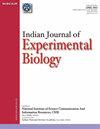除草剂Almix和excelmera 71对印度硬骨鱼化石的神经毒性研究
IF 0.7
4区 生物学
Q4 BIOLOGY
引用次数: 0
摘要
人口爆炸和可耕地同时迅速减少,增加了农药和除草剂的使用,以确保粮食安全。然而,不加控制地使用有毒杀虫剂/除草剂,特别是有机磷和磺酰脲,已导致全世界死亡率和发病率上升。本研究报道了除草剂excelmera71和Almix在亚洲刺鱼化石(Heteropneustes化石,Bloch)脑组织病理学上的神经毒性作用。施用除草剂excelmera 71 (17.2 mg/L)和Almix (66.67 mg/L) 30 d。研究发现,视顶盖有不同程度的多个端点。海绵状突起、双核核、充血、坏死、锥体细胞增大、神经元变性、空泡化、胶质瘤、细胞水平取向异常和颗粒细胞是Excel Mera 71和al混合液处理的化石视神经顶的主要病理症状。其中,SPV(室周层)和SAC(室中央层)受除草剂影响最大。在除草剂处理下,神经坏死、神经胶质瘤、空泡化和尼索物质损失的表现非常突出,统称为神经毒性指标。这些病变在Excel Mera 71下的发生率较高,表明该除草剂比Almix具有更高的神经毒性潜力。此外,平均评估值(MAV)显示,Excel Mera 71的病理病变最高(4.06±0.02),Almix次之(3.28±0.10),对照组为(0.09±0.04)。总的来说,这些变化表明两种除草剂对大脑代谢,包括感觉模式,视觉外观和运动协调产生不利影响。因此,视顶叶病理变化可作为环境毒物神经毒性评价的生物标志物。本文章由计算机程序翻译,如有差异,请以英文原文为准。
Neurotoxicity induced by herbicides Almix and Excel Mera 71 in the Indian teleost Heteropneustes fossilis (Bloch)
Population explosion and simultaneous rapid loss of cultivable land escalated the use of pesticides and herbicides to ensure food security. However, uncontrolled application of toxic pesticides/herbicides, particularly organophosphorus and sulfonylurea, has resulted in increased mortality and morbidity worldwide. The present study reports the neurotoxic effect of herbicides Excel Mera 71 and Almix based on brain histopathology of the Asian stinging fish, Heteropneustes fossilis (Bloch). Herbicides, Excel Mera 71 (17.2 mg/L) and Almix (66.67 mg/L) were administered to fish for 30 days. Study showed several endpoints in optic tectum with varying degree. Spongiosis, binucleated nuclei, congestion, necrosis, enlarged pyramidal cells (EPC), neuronal degeneration, vacuolization, gliosis, aberrant horizontal cell orientation and granular cells were prominent pathological symptoms in optic tectum in Excel Mera 71 and Almix-treated H. fossilis. Among the six layers, SPV (stratum periventriculare) and SAC (stratum album centrale) layer were maximally impacted by herbicide exposure. Appearance of neural necrosis, gliosis, vacuolization and loss of Nissl substances, collectively called neurotoxicity indicators, were very prominent under herbicides treatment. Higher prevalence of these lesions under Excel Mera 71 indicated that this herbicide has higher neurotoxic potential than Almix. Additionally, mean assessment value (MAV) indicated highest pathological lesions in Excel Mera 71 (4.06 ± 0.02), followed by Almix (3.28 ± 0.10) compared with control fish (0.09 ± 0.04). Collectively, these alterations indicated that both herbicides caused adverse effects on brain metabolism including sensory modalities, visual appearances, and motor coordination. Accordingly, brain optic tectum pathological changes can be utilized as biomarker of neurotoxicity evaluating of environmental toxicants.
求助全文
通过发布文献求助,成功后即可免费获取论文全文。
去求助
来源期刊
CiteScore
1.57
自引率
33.30%
发文量
84
审稿时长
6 months
期刊介绍:
This journal, started in 1963, publishes full papers, notes and reviews in cell biology, molecular biology, genetic engineering, endocrinology, reproductive biology, immunology, developmental biology, comparative physiology, radiation biology, chronobiology, microbiology, pharmacology, toxicology and other biological fields including instrumentation and methodology. The papers having experimental design involving alteration and/or manipulation in biological system(s) providing insight into their functioning are considered for publication. Studies involving higher animals, human beings and of clinical nature are not encouraged for publication in the journal.

 求助内容:
求助内容: 应助结果提醒方式:
应助结果提醒方式:


